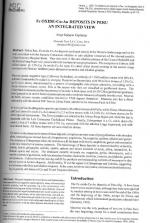Добрый день, Коллеги. Важное сообщение, просьба принять участие. Музей Ферсмана ищет помощь для реставрационных работ в помещении. Подробности по ссылке
Fe Oxide-Cu-Au Deposits in Peru: An Integrated View
Within Peru, Fe oxide-Cu-Au deposits are found mainly in the Western Andes range and on the coast, associated with the Jurassic-Cretaceous alkaline to calc-alkaline volcanism of the aborted ensialic Canete-Huarmey Marginal Basin. They also exist in the calc-alkaline plutons of the Coastal Batholith and theTholeiite Patap Super-unit, associated with continental margin processes. The exception is Cobriza (100 million tonnes' @ 1.5% Cu, Fe oxide-Cu-Au type; Cu calcic distal skarn) existing in the eastern range associated with Permian Tardihercynian distensive tectonics and alkaline granites.
Marcona (apatite-magnetite type; Callovian-Oxfordian), an orebody of >1500 million tonnes with 60% Fe, and Raul-Condestable (Fe oxide-Cu-Au type; Hauterivian-Barremian), with 50 million tonnes of 1.5% Cu, are Fe calcic skarns, characterised by a pattern of stratigraphic calc-silicate alteration, coinciding with a fissure intrusive-volcanic centre. This is the reason why they are classified as geothermal skarns. The Caiiete Basin is characterised by the presence of ocoites2 a thick crust, with 20-30°C/Km geothermal gradients, burial greenschist to zeolite facies metamorphism and a moderate intrusion of mantle into the crust. More to the North, extreme oceanic conditions resulted in VMS deposit formation. Marcona also has a direct relationship with the dextral NW Treinta Libras Fault, similar to the Atacama Fault in Chile.
Fe-Acari and Yaurilla (Magnetite-apatite type) contain 40 million tonnes of 66% Fe, while Eliana, Monterrosas and Cata Cafiete (Fe oxide-Cu-Au) amount to 2.5 million tonnes with 1.5-2.6% Cu. All these skarns are Fe calcic type and late-tectonic. The first examples are related to the Albian Patap Super-unit while the last is associated with the Late Cretaceous Cochahuasi Pluton. Finally, Cobrepampa is a Cu calcic skarn (Fe oxide-Cu-Au) of 5 million tonnes with 2-5% Cu, associated with the alkaline Linga Super-unit, and with local dextral faults. All these deposits are auto-reaction skarns.
The district wide alteration for most of these deposits comprises an outer zone of propylitisation with abundant albite, surrounding an internal halo of clinopyroxene, amphibole, Na-scapolite, epidote, chlorite and garnet. The exception is Cobrepampa where the alteration is K-feldspar with biotite, amphibole, garnet and tourmaline as the most important accessory minerals. The mineralogy of these deposits is characterised by actinolite, chlorite, biotite, phlogopite, sericite, apatite, sphene and minor amounts of rutile, albite, tourmaline, K-feldspar, quartz and calcite. The dominant metallic minerals are magnetite, pyrite, chalcopyrite, and a variable contents ofpyrrhotite, with less abundant bornite, chalcocite, covellite, ilmenite, molybdenite, galena and sphalerite. Cobriza however, has Ag and Bi by-products and outstanding contents of arsenopyrite that are very scarce in Andean deposits. Additionally, W and Sn appear in Cobrepampa and Cobriza, suggesting a relationship with felsic and alkaline magmas. In the coast, however, Au (native, electrum and solid solution), Ag (in galena), and traces of Co and Ni are frequent elements.




